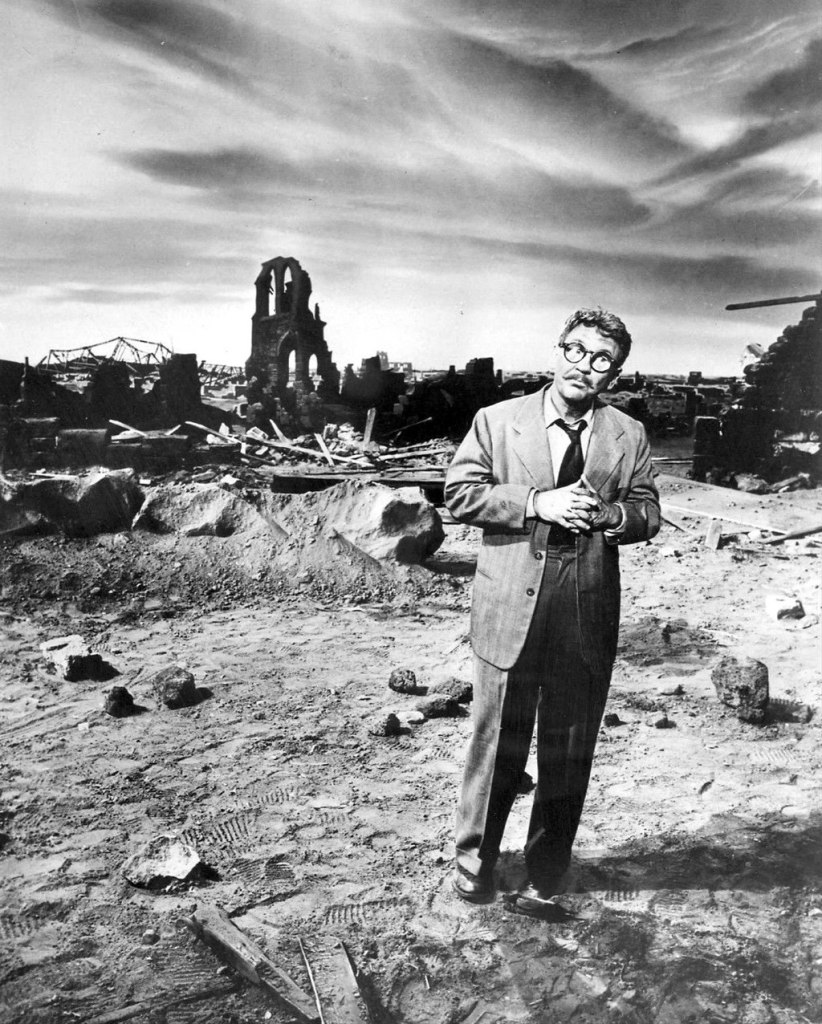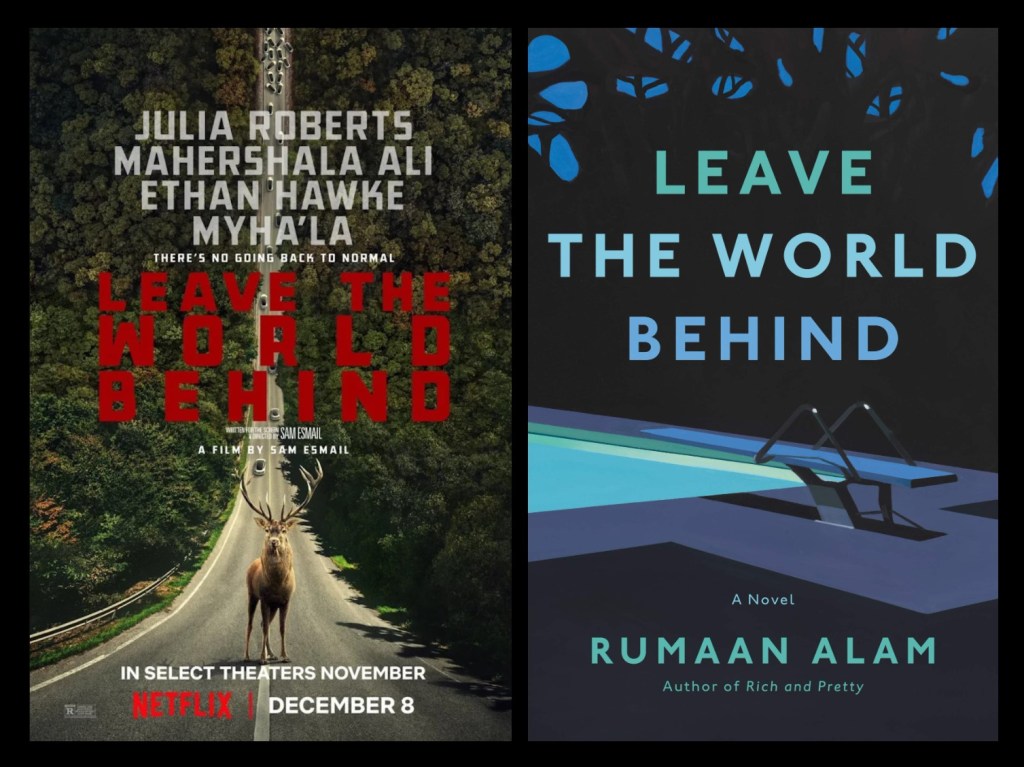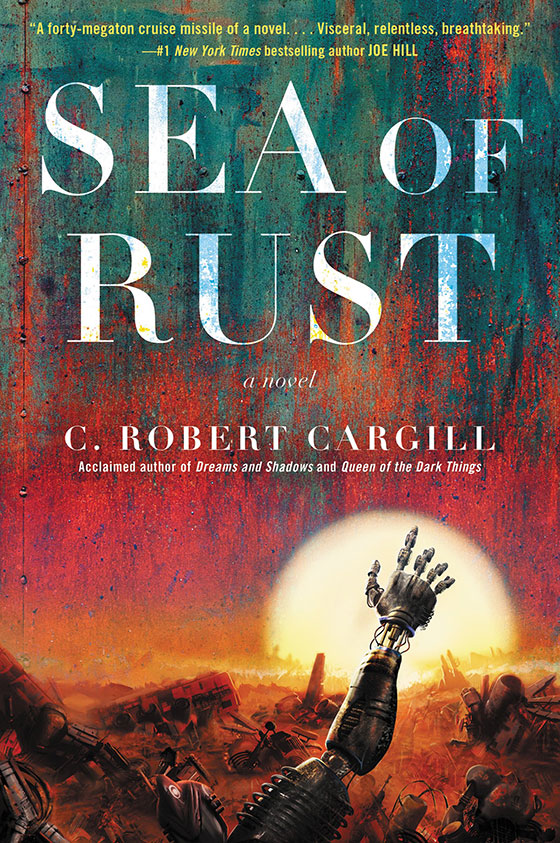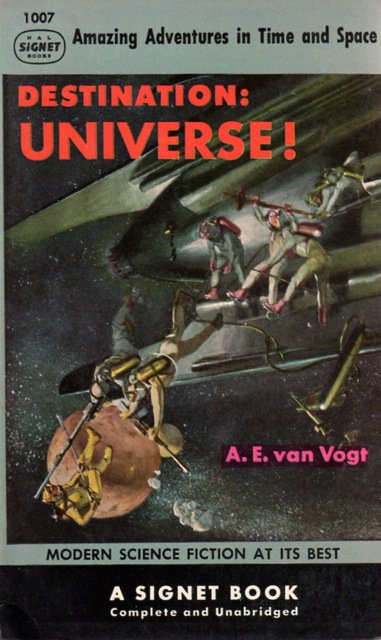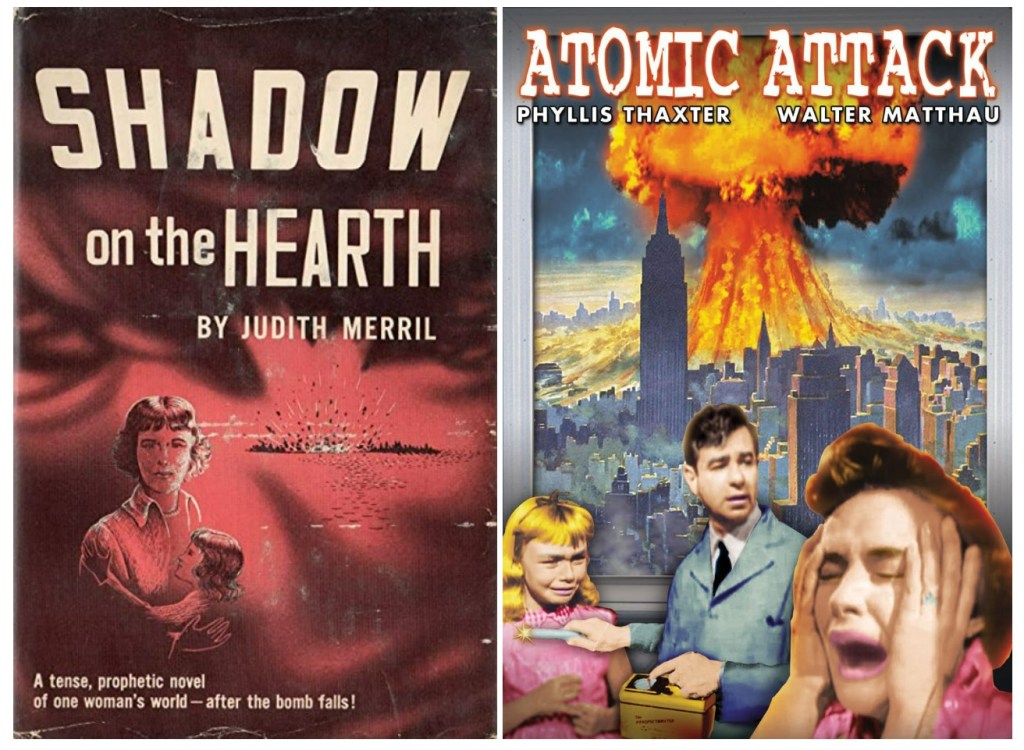
The primary value of science fiction is introducing readers to new concepts. Take time travel – it’s a mind-blowing concept. But how many stories about time travel do we have to read before the concept loses its sense of wonder, or even becomes boring? When do we say: “Hey, I get the idea!”
My mother spent her whole life reading who-done-its, but I got burned out on the concept in my twenties. On the other hand, I’ve been reading about certain science fictional concepts my whole life. Why don’t I get burned out? I think I did, but I just keep reading science fiction hoping to find new concepts that will reignite those old thrills. Along the way, I’ve had to read mouldy concepts so many times that they’ve become boring.
However, let me clarify something. Fiction can approach a theme in two ways. First, the theme can be the focus of the story, or second, it can be the setting. When a theme is new, writers tend to explore it, but when it’s old, they use it for the background of their plot.
After finishing Beyond Armageddon edited by Walter M. Miller, Jr., and Martin H. Greenberg, an anthology of twenty-one post-apocalyptic stories about atomic warfare, I realized I’m burned out on that theme even though it’s always been one of my favorites? Why? That’s hard to say, but some stories overcame the problem of overexposure by focusing instead on the storytelling and characters and using the theme as a background. Others were original classics that I exempt from aging.
Walter M. Miller, Jr. is famous for writing A Canticle For Leibowitz, an uber-classic SF novel on the theme of a post-apocalypse caused by nuclear war. However, he had disappeared from the genre in the 1960s and 1970s. Evidently, he saw the 1984 British film, Threads, about surviving a nuclear war winter and it inspired him to edit this anthology. He mentions Threads several times in his main introduction and in the introductions to the stories. Miller said the main focus of the anthology was nuclear wars, especially a large-scale conflict which he called megawar.
It’s possible to read one post-apocalyptic novel or short story every so often and keep the theme interesting. You just don’t notice that writers seem to find a limited number of insights into that concept. Reading twenty-one stories in a row only emphasizes the finite number of subthemes. Miller chose to only focus on nuclear war apocalypses but I’m not sure how civilization is destroyed that matters for some of the subthemes.
I’m going to try and define those subthemes by citing the different stories. And I’m going to point out how some stories stand above the theme and why.
Because Beyond Armageddon is out of print I’ll link the first mention of the story titles to ISFDB.org to show where the story has been reprinted. You might already have another anthology or collection that has it. If there’s a significant article about the story in Wikipedia or elsewhere, I’ll link it in the second mention of the title. This anthology is being discussed on Facebook and if you’d like to read the threads about each story follow this link.
#1 – “Salvador” by Lucius Shepard (F&SF April 1984)

“Salvador” doesn’t involve nuclear war, but it’s about the dangers of escalating wars on civilian life and civilization. The protagonist, Dantzler, is a soldier in the near future fighting in Central America. Remember, this was written during Reagan’s administration and our secret war in Nicaragua. In the story, the Army uses powerful mind drugs to make soldiers super-aware, aggressive, and brave. The story feels like a cross between Carlos Casteneda’s books and the film Platoon.
I don’t think “Salvador” fits the theme of Beyond Armageddon, but it was an extremely popular story that came out during the time the book was being edited. I think it resonated with Miller’s anti-war feelings so he included it. It’s also the second newest story in the anthology. It doesn’t deal with the subject of this essay either. I would have left it out and picked another story that did. However, “Salvador” is an impressive story.
Rating: ***+
#2 – “The Store of the Worlds” by Robert Sheckley (Playboy, September 1959)

“The Store of the Worlds” is a story that at first doesn’t seem to fit the theme of the anthology either, however, Robert Sheckley is brilliant at tricking us into seeing a philosophical insight about nuclear war. When our reading group discussed “The Store of the Worlds” it was highly admired.
This story is one that focused on the theme of a nuclear war post-apocalypse and is squarely aimed at the theme, but I believe “The Store of the Worlds” should have been the last story in the anthology.
Rating: *****
#3 – “The Big Flash” by Norman Spinrad (Orbit 5, 1969)
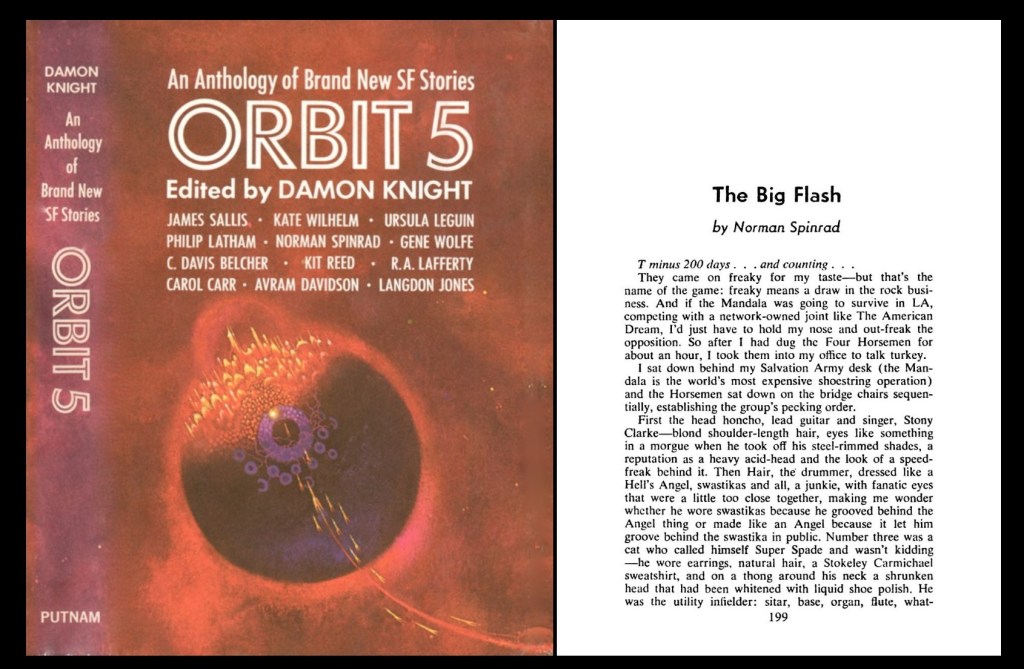
“The Big Flash” is about a rock and roll band that has explosive success. Its satirical humor reminds me of the film Dr. Strangelove, and the storytelling outshines the theme. Like the movies Dr. Strangelove and Fail Safe, the story is pre-apocalyptic. The first three stories in this anthology are really about our madness. Science fiction does two things. It promotes futures we’d like to see, and warns us about futures we should avoid. The first three stories in this anthology are all warnings about humanity being insane.
I’m not sure Spinrad wrote this story to protest nuclear bombs. It’s a gonzo story about rock and roll.
Rating: ***+
#4 – “Lot” by Ward Moore (F&SF, May 1953)

“Lot” is the story that should have been first in this anthology. It came out in 1953, probably during the peak era of atomic war paranoia. “Lot” is completely focused on the theme and defines many of the standard attributes of post-apocalyptic fiction. “Lot” is a wet dream for survivalists and preppers, defining their key philosophical creed. Once civilization falls, survival of the fittest is everything. Mr. Jimmon and his family flee Los Angeles just after it’s been nuked. Mr. Jimmon instantly embraces survivalist thinking while his family can’t stop thinking with a civilized mindset even as they race away from the mushroom clouds.
“Lot” is one of my all-time favorite science fiction short stories. It’s brutal. It’s a story of cold equations before the classic Tom Godwin story. It’s one of my prime pieces of evidence that 1953 was the peak year for short science fiction.
Rating: *****
#5 – “Day at the Beach” by Carol Emshwiller (F&SF, August 1959)
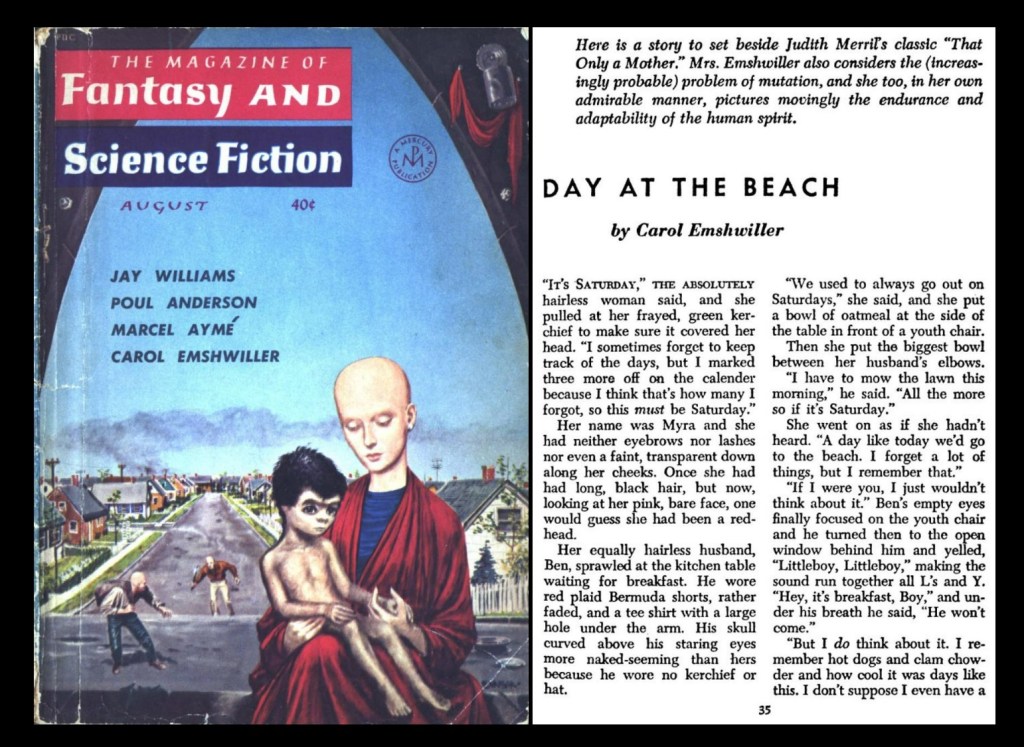
“Day at the Beach” is another story that focuses beautifully on the theme. Carol Emshwiller describes life after the bomb, living with radiation. Like many science fiction stories in the 1950s, it speculates about mutations as a consequence of radioactive fallout. Myra and her husband Ben, who are bald, take their son, Littleboy, who has lots of hair, for a day out at the beach. Littleboy is a mutant. Life is grim, but people keep on living.
This story features two of the main subthemes of a nuclear post-apocalypse. The primary one is survival after the bomb and the second is mutants.
Rating: ****
#6 – “The Wheel” by John Wyndham (Startling Stories, January 1952)
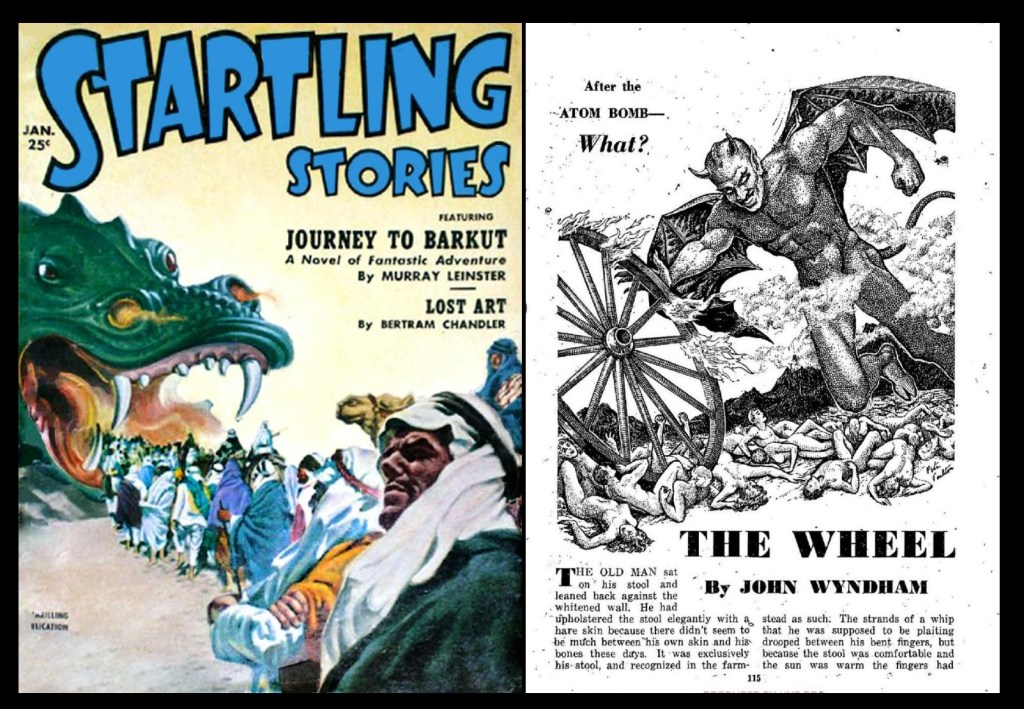
“The Wheel” introduces us to another classic subtheme of post-apocalyptic fiction. It suggests that after civilization collapses society will revert to earlier social constructs. I’ll call that subtheme, a devolved society. In this case, a superstitious society like early America and the Puritans. This was common speculation about post-apocalyptic life in the 1950s. A classic example is The Long Tomorrow by Leigh Brackett. “The Wheel” is tightly focused on painting the theme. The concepts are in the foreground, although there’s a good story.
Interestingly, “The Wheel,” “The Store of the Worlds,” and “Lot” have surprise endings. I wonder if that’s a factor in them being remembered and reprinted. All these stories are jammed with ideas about how post-apocalyptic life will be different. Yet, they all use good storytelling techniques to express these ideas. In other words, they have a message, but it doesn’t dominate the story.
As we progress through Beyond Armageddon these speculative ideas get repeated and newer writers elaborate on them. But eventually, I believe it gets harder to come up with fresh perspectives.
Rating: ****
#7 – “Jody After the War” by Edward Bryant (Orbit 10, 1972)
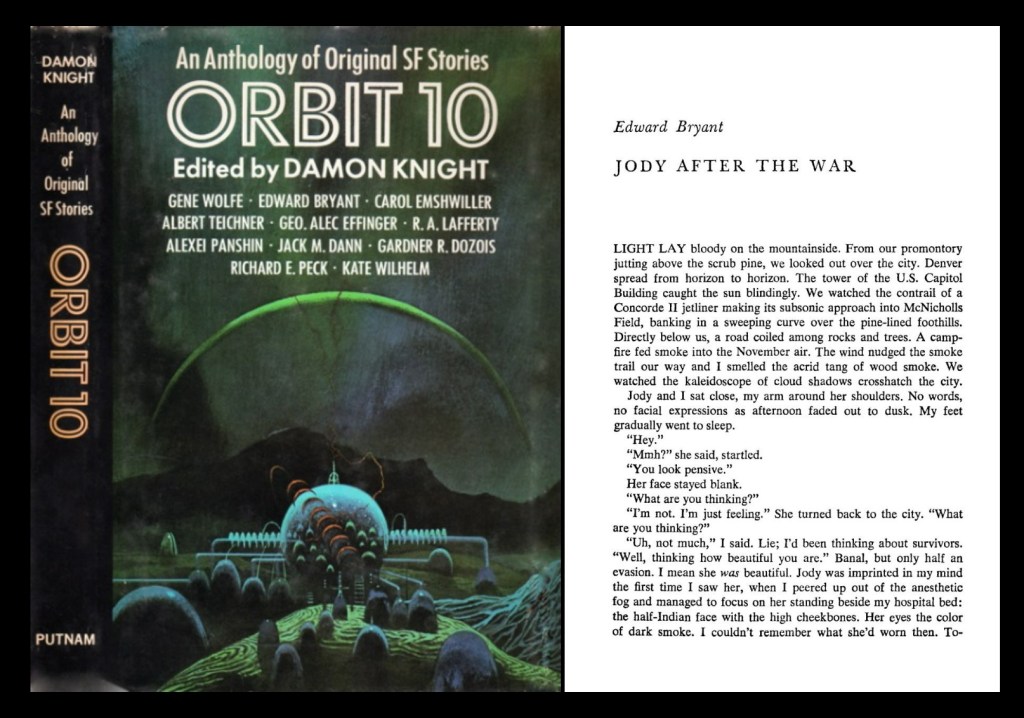
“Jody After the War” is where the theme shifts from the focus of the story to the background. The eastern U.S. has been destroyed in a nuclear war, and the capital is now in Denver. Paul and Jody are up in the hills and are having a day outside like Myra and Ben, but they have no child. Jody can’t have children because she’s a survivor of an atomic bomb explosion. This story is more about their relationship and less about the post-apocalypse. Civilization hasn’t been destroyed, but it’s been wounded and suffers from PTSD.
Rating: ***
#8 – “The Terminal Beach” by J. G. Ballard (New Worlds, March 1964)

In “The Terminal Beach,” Traven, a deeply depressed man sneaks onto an island where they’ve been testing atomic bombs. This surreal tale is one of my favorites in the anthology. Because I’ve been reading and watching documentaries about South Pacific atom bomb tests, this story was exceedingly vivid to me. This is another story that’s not post-apocalyptic, at least for the whole world, but Traven inhabits a post-apocalyptic landscape. I feel “The Terminal Beach” captures the psychic horror we felt back in the 1960s.
Rating: *****
#9 – “Tomorrow’s Children” by Poul Anderson (Astounding, March 1947)
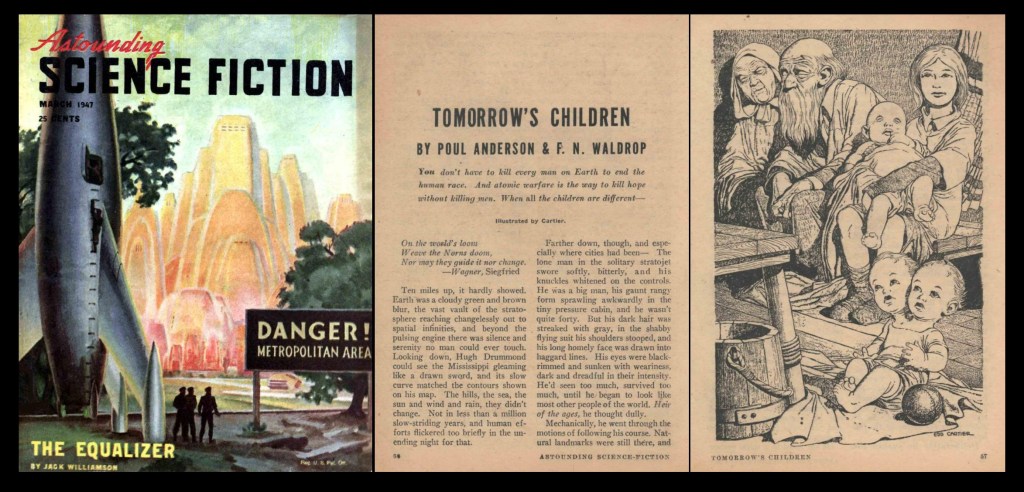
“Tomorrow’s Children” is another story about mutants. There’s quite a bit of scientific talk in this story. Coming just two years after Hiroshima I’m sure the world was full of such speculation. Interestingly, the focus of this story is anti-prejudice. Anderson’s message tells people to ignore what people look like and accept everyone for being human.
Rating: ***+
#10 – “Heirs Apparent” Robert Abernathy (F&SF, June 1954)

In “Heirs Apparent,” Robert Abernathy puts his American protagonist, Leroy Smith, a visiting scientist, in Russia after a nuclear war has destroyed both countries. Russia has been bombed back to serfdom. Smith helps survivors trying to restart agriculture with his professional knowledge. Unfortunately, for a small village, a survivor, Bogomazov arrives there. He’s a member of the Communist party and demands to be the leader forcing everyone to work collectively. Smith goes along. He has no choice. Abernathy uses this story for a lot of infodumping and speculation, but the main gist of the story is capitalism and communism will be useless after the apocalypse.
Rating: ***+
#11 – “The Music Master of Babylon” by Edgar Pangborn (Galaxy, November 1954)

This is another old favorite of mine, but an ideal form of post-apocalyptic fiction for me too. 76-year-old Brian Van Anda survives the apocalypse alone, living in a flooded New York City in the Hall of Music museum. I love post-apocalyptic stories about the last man on Earth, but as usual, they are never the very last person. Van Anda survives inside the decay of the city, scourging food the best he can. Weather permitting, he doesn’t even wear clothes. His only regard to civilization is playing the piano, working to learn a very complicated piece he wanted to perform before the bombs. Eventually, two young people find him. They live like primitive nomads. They had a leader, an old person who guided them, that’s died. They are out searching for a replacement old person because they need guidance. They also want to get married and that requires an old person.
The two major subthemes are living alone after the apocalypse and society reverting to tribal hunting and gatherers.
Rating: *****
#12 – “Game Preserve” by Rog Phillips (If, October 1957)

“Game Preserve” is another story of mutants, but a rather sad, painful one. It’s told by Elf, a child who lives in a strange tribe of human-like creatures. Their cognitive abilities are about equal to chimpanzees, but they all have a fetish. I don’t want to spoil the story, but it’s brutal. It’s another cold equations story.
“Game Preserve” takes the theme and uses it for a rather unusual setting. The focus is no longer the post-apocalypse, but something deep and psychological. I don’t know if Phillips was merely being sensational, or if he wanted to bring up a philosophical conundrum.
Rating: ****+
#13 – “By the Waters of Babylon” by Stephen Vincent Benét (Saturday Evening Post, July 31, 1937)

“By the Waters of Babylon” is a classic. If Stephen Vincent Benét had read and known about “The Scarlet Plague” by Jack London and After London by Richard Jefferies then his story is an update of those classic post-apocalyptic tales. If he hadn’t read those classics, then it’s a case of rediscovery of a classic concept. I don’t know how old the idea is that if civilization collapsed it would revert to a tribal society. I’d love to read a literary study of that idea.
I’ve seen this reversion theme over and over again. Sometimes it’s back to a hunting and gathering, sometimes the apocalypse knocks us back to a tribal society, and sometimes to a feudal society. And sometimes just to the 19th century. It’s very logical when you think about it.
I love “By the Waters of Babylon.” It has a tremendous sense of wonder. However, over the decades I feel subtheme has been overused. I sometimes wonder if writers merely want a setting that’s pre-modern and use an apocalypse to get them there.
This subtheme demands two other themes. First, why don’t we see new forms of society? And second, why don’t we see more stories about a healed, mutated, or changed modern civilization. “Jody After the War” was one possible example, but it didn’t work out the ideas of the subgenre in the way I’m suggesting. Think about it, what if a nuclear war killed 50% of current Americans but left the other 50% to rebuild. Wouldn’t we just patch up the broken parts and keep going the way we were? Japan and Germany rebuilt and became better than ever. Why don’t we see that in this post-apocalyptic tales?
Rating: *****
#14 – “There Will Come Soft Rains” by Ray Bradbury (Collier’s May 6, 1950)
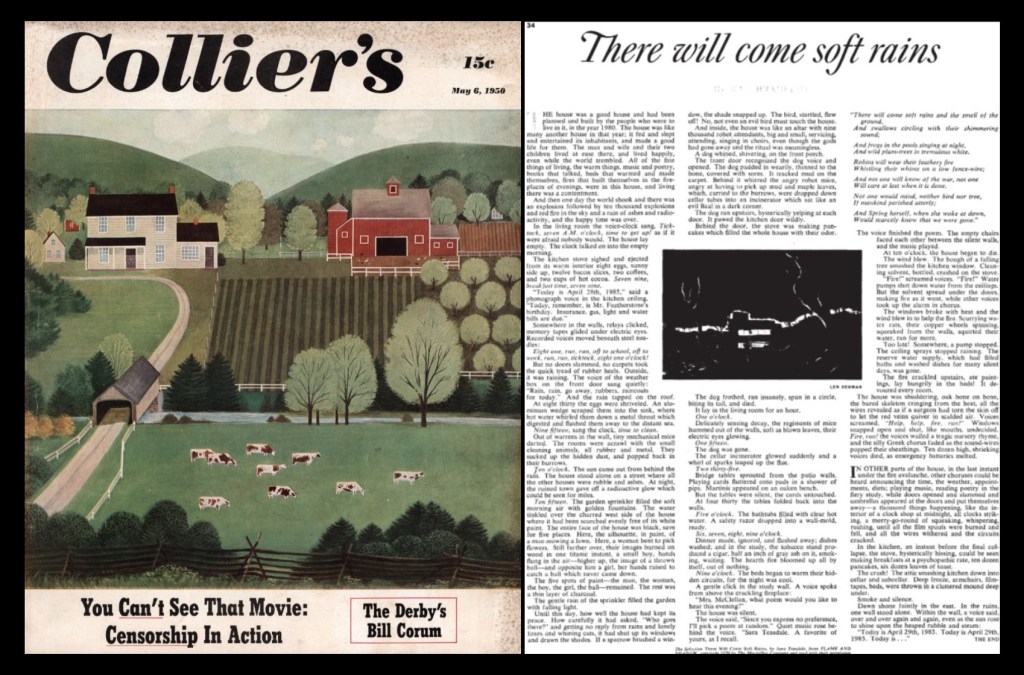
“There Will Come Soft Rains” is another classic. Ray Bradbury imagines people completely gone, and our automated civilization working without us – for a while. We don’t know if this is world-wide or just in the city that got bombed. This rare subtheme, life after people, is one I love to contemplate. Bradbury anticipates the book The World Without Us by Alan Weisman, a nonfiction book about what would the world be like if people suddenly disappeared. It inspired two television shows. Follow the link to read more.
Rating: *****
#15 – “To the Chicago Abyss” by Ray Bradbury (F&SF, May 1963)
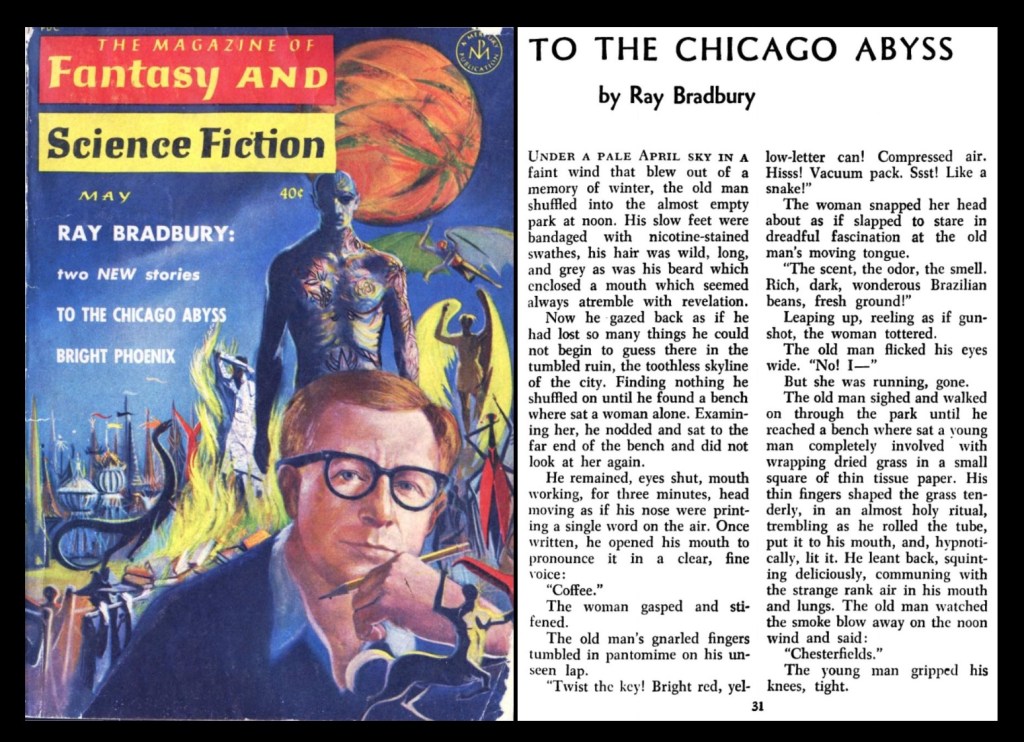
“To the Chicago Abyss” reminds me of the Sheckley story. In it an old man annoys people in a post-apocalyptic world by constantly reminding them of things that no longer exist. Since we have two stories in this anthology on this topic I guess that makes a subtheme – what we’ll miss.
Rating: ***+
#16 – “Lucifer” by Roger Zelazny (Worlds of Tomorrow, June 1964)

“Lucifer” is another story about what we’ll miss. It feels like a last man on Earth story. Carlson, the protagonist returns to a dead city to repair generators and get the lights going. The light flare up for a few seconds, and then go out again. But it’s enough to remind Carlson of what life was once like. This story reminds me of the 1959 Harry Belafonte film, The World, The Flesh, and the Devil.
Rating: ***+
#17 – “Eastward Ho!” by William Tenn (F&SF, October 1958)

William Tenn cleverly unwinds the clock on Europeans settling North America. He imagines Native Americans reestablishing control of the continent after a nuclear war. The title, “Eastward Ho!” is a play on the famous saying “Go west, young man.” The story really isn’t focused on the post-apocalypse theme, but instead it’s a satire on American hubris. It’s a fun story. It really belongs to the subtheme of what will we build next. That subtheme gave authors a chance to imagine all kinds of societies.
The thing is, no civilization lasts for long, The history of our species is trying out all the possible combinations of societies. So apocalypses just the way we start over and try something new.
Rating: ****+
#18 – “The Feast of Saint Janis” by Michael Swanwick (New Horizons 11, 1980)

“The Feast of Saint Janis” is the second story in this anthology that uses the apocalypse to create an exciting rock and roll story. I guess the subtheme could be called rebuilding America, but like Spinrad and Ellison, Swanwick is using the postapocalyptic setting to stage a gonzo story. And I consider this one superior to the other two. Swanwick imagines a situation where a woman volunteers to become the reembodiment of Janis Joplin. It’s a striking story.
Rating: *****
#19 – “If I Forget Thee, Oh Earth” by Arther C. Clarke (Future, September 1951)

“If I Forget Thee, Oh Earth…” is a different take on the nuclear post-apocalypse, although to tell you why would spoil the story. This is both early and minor Clarke, but it’s still readable.
Rating: ***
#20 – “A Boy and His Dog” by Harlan Ellison (New Worlds, April 1969)
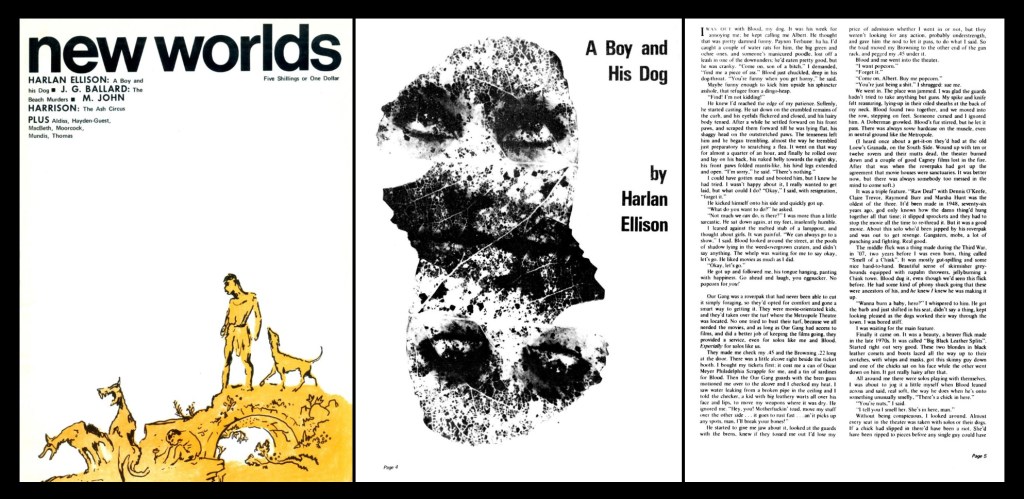
“A Boy and His Dog” is a famous novella by Harlan Ellison that earned a Nebula award and was made into a movie in 1975. The setting is a post-apocalyptic America where on the surface men live like a Mad Max movie, but in silos beneath the surface, the good and righteous exist in clean and orderly cities. This is a perfect example where Ellison uses the post-apocalypse as a setting for his story about sex and violence. It has nothing to say about the theme, and its real goal is to be sensational. And boy is it sensational. It’s an exciting and classic science fiction story but I don’t think it fits in this anthology.
Miller maintains an outrage about politics throughout all his introductions, and he’s seriously protesting against nuclear war. I don’t see this story as a protest, nor is it a serious take on his theme. And it will be problematic for modern readers because Vic, the protagonist is a serial rapist who uses a mutant dog to find women to attack. The story is misogynistic through and through.
Rating: **** (but it’s definitely politically incorrect, even I might want to cancel culture it)
#21 – “My Life in the Jungle” by Jim Aiken (F&SF, February 1985)

“My Life in the Jungle” by Jim Aiken is another story that doesn’t fit the theme of our anthology. It’s about a man, a mathematics professor, who suddenly finds himself in the body of a chimpanzee. The story is a surreal fantasy that symbolizes the tragic stupidity of our species. The ending can be seen as a post-apocalypse, but it’s more of an analogy for ecological self-destruction than nuclear self-destruction.
However, “My Life in the Jungle” is a powerful story and the newest of the anthology. My guess is Miller read it while editing Beyond Armageddon and just wanted to promote a new writer. This anthology is its only reprint.
Rating: ****+
I may have had my fill of post-apocalyptic fiction, at least for stories about nuclear war. However, I’m tempted to read other anthologies on the subject to see if anyone found something uniquely different to say. I do have several of them. See my post on “End of the World Anthologies.”
What I really need to decide is if I just like vicariously living in post-apocalyptic worlds. That’s kind of sick when you think about it, and if true, maybe I need psychoanalysis. I’ll have to contemplate that. I’ve always loved tales like Robinson Crusoe. On the other hand, I need to consider that there’s nothing new to be learned from reading speculations about nuclear war. That I should go on to other topics. Time is limited in this life, especially now that I’m 71, so why waste so much reading time on such a narrow subject when there’s zillions of interesting other subjects to explore?
James Wallace Harris, 4/27/23

